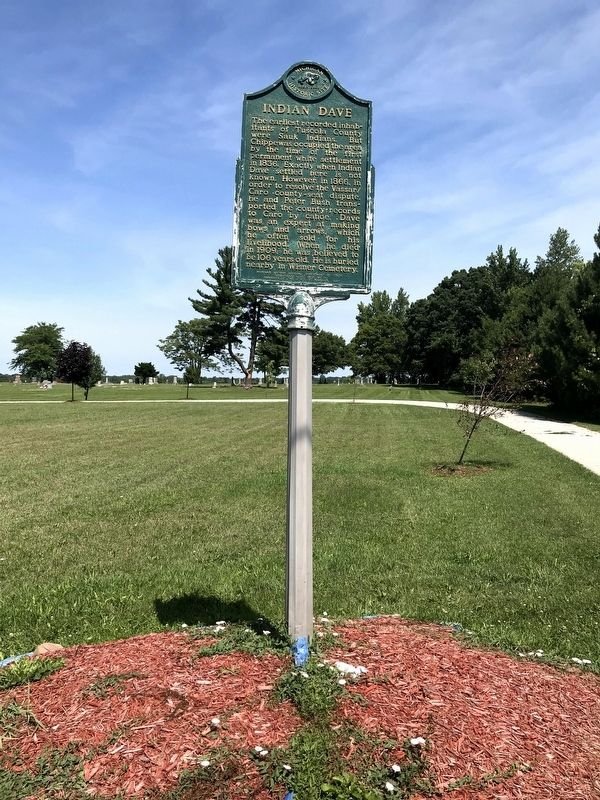AJ Phillips Fenton Museum
The A.J. Phillips Fenton Museum is an original building from 1900. AJ Phillips' heirs donated the building to the city in 1906. Most recently, the building housed the Fenton Library (now the Jack R. Winegarden Library) until it moved to its present location in the old Post Office.
Juniata House
In 1851, Patrick McGlone (1810-1884) settled near here. Later, he built a one-story Greek Revival Style building that he named “Juniata House” where he provided lodging and food for travelers, as well as “good Barns” stocked “with hay and grain.” His family served travelers for fourteen years.
Indian Dave
Indian Dave was one of the last Chippewas to hunt, fish, and trap in the old manner in the Tuscola County area. Dave was born around 1803 and given the name Ishdonquit. When he died in 1909, he was believed to be 106 years old. He is buried nearby in Wisner Cemetery.
Gilford United Methodist Church
In 1889 Charles and Naomi Phipps donated land for a church building. Church members laid the cornerstone later that year. In 1968, through a merger with the Methodist denomination, the name became the Gilford United Methodist Church.
Frankenhilf
In 1849 Pastor Ferdinand Sievers of Bay County purchased over fifteen hundred acres of virgin forest here in Tuscola County to establish a colony of immigrants from revolution-torn Germany. They named their community Frankenhilf, combining Franconia, a district of Bavaria, and hilf, meaning assistance.
First Presbyterian Church of Caro
For the first year, this small group of Presbyterians held their worship and prayer services in the homes of members. Then in 1880, they erected their first house of worship on Lincoln and Pearl Streets. It has had no structural alterations since construction. A regal structure, it features a corner tower and stained glass windows.
Elkland Township Hall
This hall was built in 1881 as the center of government activity for Elkland Township. Erected at a cost of twenty-six hundred dollars, it was the first brick structure in Cass City.
First Presbyterian Church
Three people gathered in June 1877 to form the First Presbyterian Society of Cass City. The congregation soon called its first pastor, the Reverend John Kelland, who led fundraising efforts to build a permanent home for the society. By the fall of 1878, a wood building was erected on this site.
White Rock School
Named after a boulder in Lake Huron that was used as a landmark in the Indian Treaty of 1807, the village was settled about 1860. Destroyed in the Great Fire of 1871, the town was soon rebuilt, including a schoolhouse. The present building was constructed in 1909.
The Indian Mission
On July 1, 1845, three Lutheran missionaries, Reverend Johann J. F. Auch, Reverend J. Simon Dumser, and Reverend George Sinke, arrived to evangelize the Chippewa Indians. A log chapel was built here later that summer.
Stagecoaches
Stagecoaches played an important part in developing the Midwest. Michigan’s frontier “fever” peaked in the decade from 1830 to 1840 with a 600 percent population increase. Stagecoaches attempted to fill the demand for fast and relatively comfortable transportation.
St. Mary of Czestochowa Roman Catholic Church
The Polish refugees who immigrated to Dwight Township in the 1840s in order to escape Prussian domination worshipped at St. Michael’s Catholic Church in Port Austin. In 1903, in an effort to retain their Polish identity, they established their own parish and built St. Mary of Czestochowa Church, named for “the Queen of Poland.”
Sebewaing Township Hall
Sebewaing Township was organized in 1853. In 1877 the board resolved to use “liquor money” to build this township hall. The atypical two-story town hall included voting booths, a courtroom, a jury room, a jail, and a meeting hall.
Port Hope Chimney
This chimney was built in 1858 by John Geltz. It is all that remains of the lumber mill established that year by William R. Stafford. Port Hope grew up around the mill. For a score of years, this town was a center of lumbering in the Thumb. It also became an important producer of salt.
Pointe aux barques lighthouse
The Pointe aux Barques Lighthouse and Lifesaving Station aided mariners for over a century, beginning in 1847. That year the U.S. Lighthouse Service built the first lighthouse on this site to mark the turning point of Lake Huron into Saginaw Bay and to warn of shallow waters.
Pigeon Depot
The Pigeon Depot was constructed in 1908 and served two railroad lines. In 1883 the Pontiac, Oxford, and Port Austin Railroad, a north-south line, had been extended to Caseville and a depot was built at Berne, one mile north of here.
Owendale Marker
In 1882, as three new railroads began to lay track in Huron County, two cousins from Saginaw, John G., and John S. Owen, bought land in the Columbia Swamp. The following year, they opened a sawmill to harvest the native oak.
Methodist Episcopal Church
In 1868 the Reverend Manasseh Hickey and twelve settlers organized a Methodist Episcopal church in Caseville. Services were held in a schoolhouse until the present church was built. Upon its dedication on November 15, 1874, the Gothic-inspired structure, with its 70-foot-high steeple, became a focal point for the community.
John C. Liken/John C. Martini House
One of Sebewaing’s most prominent citizens, John C. Liken (1832-1920) came here in 1865 from New York State lured by Michigan’s bountiful forests, he opened stave and sawmills in Sebewaing, Unionville, Akron, and Fairgrove. His firm, John C. Liken and Company, dealt in a variety of commodities that the company’s fleet of ships transported to Bay City and markets in New York.



















